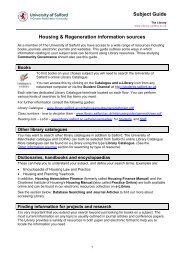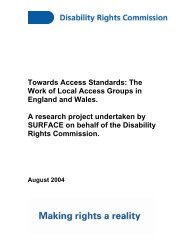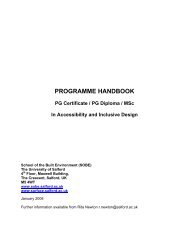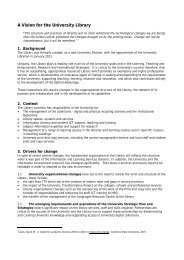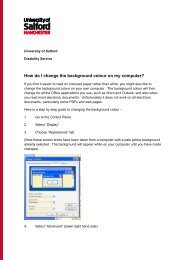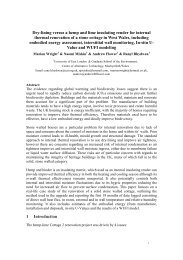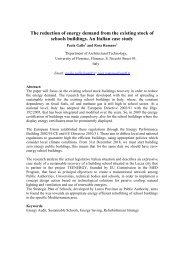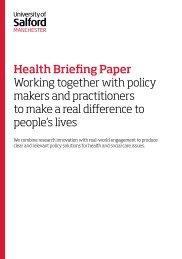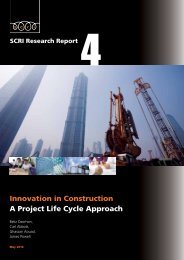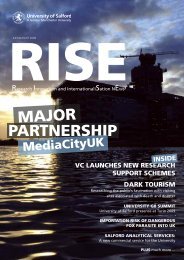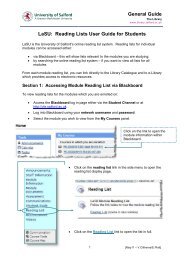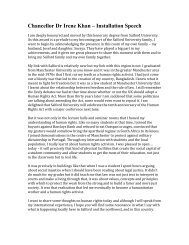FINAL REPORT - University of Salford
FINAL REPORT - University of Salford
FINAL REPORT - University of Salford
You also want an ePaper? Increase the reach of your titles
YUMPU automatically turns print PDFs into web optimized ePapers that Google loves.
8<br />
Early preventative Intervention<br />
Although response guidelines have been routinised<br />
in safeguarding (DCSF 2010) and assessment work<br />
(DH 2000) for some time, the response that families<br />
receive at lower thresholds can involve significant<br />
delay. What the MARP has attempted to do is to<br />
shorten the normal ‘drift’ that occurs when a family<br />
is referred between several agencies. One advantage<br />
<strong>of</strong> a speedy response is that it is hoped that early<br />
intervention will prevent some families from reaching<br />
the Safeguarding threshold.<br />
(PM) The MARP also identifies the low-level at-risk<br />
families early. This enables effective preventative<br />
work.<br />
(PM) Early intervention to alleviate any issues before<br />
they reach crisis point.<br />
(PM) Dysfunctional families/children are identified<br />
early and interventions put in place before further<br />
escalation.<br />
(PM) Quick access to services.<br />
(SM) Early involvement around preventative work. If<br />
we get the average young mum breast feeding then<br />
she is <strong>of</strong>f to a flying start.<br />
(SM) It is an opportunity for pr<strong>of</strong>essionals to get<br />
together round a table, in a safe arena, to talk<br />
about families they wouldn’t normally have the<br />
opportunity to talk about. The right pr<strong>of</strong>essionals<br />
are there at the meeting and can decide things<br />
swiftly.<br />
(SM) This can mean that the support is put in to the<br />
family before things begin to deteriorate.<br />
Once again, the cumbersome nature <strong>of</strong> the referral<br />
process as seen by referring practitioners reduced the<br />
impact <strong>of</strong> the intended early intervention in their view.<br />
One practitioner reported that the issues <strong>of</strong> delay<br />
caused by multi-agency involvement were still present<br />
after referral.<br />
(RP) The families end up with different agencies<br />
working with them who do not communicate<br />
well. Information is kept in separate records. This is<br />
against the recommendations <strong>of</strong> Lord Laming.<br />
Better involvement <strong>of</strong> family<br />
Another significant challenge to all preventative<br />
interventions is how well and at what stage the family<br />
are fully included in the helping process. The response<br />
from the panel members indicates that the MARP<br />
process was successful in better including families in<br />
the helping process.<br />
(PM) Parents are more involved in the process.<br />
(PM) As the relationship [with the family] develops<br />
other issues may be disclosed and, again, appropriate<br />
action can be <strong>of</strong>fered.<br />
(PM) The process provides a forum for the family to<br />
discuss problems and issues.<br />
Increased interagency communication and<br />
effectiveness<br />
The difficulties <strong>of</strong> interagency communication,<br />
information sharing and coordination between<br />
agencies in the safeguarding system have been well<br />
rehearsed over the last thirty eight years (DHSS 1974,<br />
Joint Inspectors Report 2002, Laming 2003, Murphy<br />
2004, Brandon et al 2009). Less well-rehearsed have<br />
been the difficulties <strong>of</strong> collaboration at earlier threshold<br />
stages. The Common Assessment Framework (CAF)<br />
was introduced in 2005 to help with early threshold<br />
collaboration, but difficulties in collaboration persist.<br />
The MARPs were originally intended to smooth out<br />
some <strong>of</strong> the difficulties in interagency collaboration at<br />
the threshold stages between one, two and three.<br />
Increased interagency communication, response and<br />
effectiveness were seen by panel members and senior<br />
managers to be driven by the MARP process and were<br />
held to be helpful to children, parents and practitioners<br />
alike.<br />
(PM) It <strong>of</strong>fers a swift referral system which avoids<br />
duplication <strong>of</strong> work.<br />
(PM) More effective communication.<br />
(PM) The MARP encourages interagency working to<br />
provide holistic, life-changing care to families.<br />
(PM) Effective multi-agency working, improved<br />
relationships, greater understanding <strong>of</strong> other services,<br />
improved communication.<br />
(PM) It is multi-agency so that there are a variety <strong>of</strong><br />
resources to access.<br />
(PM) Multiagency approach to information sharing<br />
about families with additional needs.<br />
(SM) It is an agreed way <strong>of</strong> sharing information. It<br />
helps practitioners unpack their assessments.



